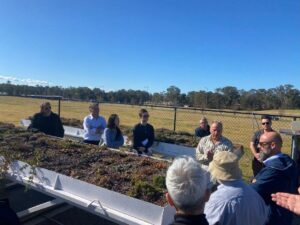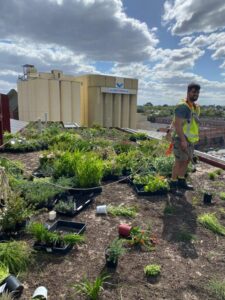
Greening Forces
The collaborative role of nurseries and urban greening professionals
By Michael Casey
Urban areas worldwide face escalating environmental challenges, including air and water pollution, heat islands, and loss of biodiversity. In response, urban greening has emerged as a critical strategy to mitigate these issues, enhancing the sustainability and liveability of cities. Central to the success of urban greening initiatives is the collaborative partnership between plant nurseries and urban greening professionals. This article delves into the multifaceted roles of both entities, explores successful collaborations, addresses challenges and opportunities, and outlines future directions for sustainable urban development.
Plant nurseries serve as indispensable hubs for biodiversity and sustainability in urban environments. They provide a diverse array of plant species essential for greening projects, catering to the unique needs and challenges of urban landscapes. Furthermore, nurseries play a vital role in propagating and distributing native species, crucial for preserving local ecosystems and supporting wildlife. Their expertise in plant cultivation and care ensures the success of greening efforts by offering guidance on species selection, planting techniques, and maintenance practices. Urban greening professionals on the other hand are at the forefront of designing and implementing green infrastructure projects that transform urban spaces into vibrant, sustainable environments. Drawing upon expertise in landscape architecture, horticulture, and urban planning, they conceptualise and execute innovative solutions tailored to urban challenges. These professionals play a pivotal role in selecting appropriate plant species, considering factors such as climate resilience, ecosystem services, and aesthetic appeal. Additionally, they oversee the management of green spaces, ensuring their long-term sustainability and functionality.
The collaborative efforts between plant nurseries and urban greening professionals have proven instrumental in achieving remarkable transformations across various urban landscapes. Through strategic partnerships, these entities have effectively addressed logistical challenges and resource limitations to supply plants for greening projects. A notable example of such collaboration can be seen in Melbourne, where nurseries and tree and plant experts partnered with the City’s Urban Forest Strategy. By reviewing and recommending a diverse array of plant species, this Urban Forest Strategy was able to significantly contribute to increasing the green cover while enhancing biodiversity within the city. Similarly, in South Australia, Trees for Life’s collaboration with local councils has led to the revitalisation of urban green spaces, fostering community engagement in environmental conservation while restoring native habitats.

This collaboration extends beyond plant supply, encompassing the exchange of crucial information between professionals. This sharing of knowledge allows nurseries to engage in research and development projects, testing and trialling new plants in various growing scenarios. Additionally, it enables urban greening professionals to discuss both the successes and failures of projects, providing invaluable feedback for growers to refine their practices and adapt to evolving challenges.
Over the years, collaboration among urban greening professionals, growers, and research faculties has resulted in numerous trials and feedback sessions. These collaborative efforts have led to the development of essential documents and programs, such as the Which Plant Where program and the Melbourne University Burnley Green Roof Plant Guide. These initiatives, among others, are funded by peak bodies dedicated to achieving successful outcomes for the horticultural sector. They provide professionals with guideline documents and programs to aid in the selection of plant material, ensuring successful outcomes in urban greening projects.
In essence, the collaborative partnership between plant nurseries and urban greening professionals serves as a cornerstone for sustainable urban development. By working together, these entities not only supply plants but also foster innovation and knowledge exchange, ultimately contributing to the creation of greener, healthier cities for present and future generations.
While collaboration brings numerous benefits, it is not without its challenges such as logistical constraints and resource limitations, which can impede collaborative efforts and project outcomes. Recent projects across Australia have highlighted the difficulties in sourcing specific plant species, especially when required in large quantities. For some rare species, procurement becomes particularly challenging, exacerbated by uncertainties regarding future demand, which may deter growers from investing in scaling up production.
Another challenge lies in the education of urban greening professionals, given the interdisciplinary nature of the field. Professionals from both the built environment and horticultural sciences are involved with the delivery of these projects, and bridging knowledge gaps is essential for effective collaboration and communication. Miscommunication or lack of understanding regarding plant growth and sustainability can hinder progress, emphasising the need for a common language and shared understanding.
Addressing these challenges, the Urban Green Infrastructure Handbook, recently published by Standards Australia, represents a significant step forward. Developed by industry professionals, this handbook aims to streamline the language used in the urban greening sector. By establishing nationally consistent terminology and providing clarity on various aspects of urban greening, such as plant selection and project requirements, the handbook minimises misunderstandings and fosters more effective collaboration in greening urban environments.
One important note to take away is these challenges present opportunities for innovation and partnership. By forging alliances with government agencies, non-profit organisations, and community groups, collaborative initiatives can leverage resources and expertise to overcome obstacles and expand impact. Additionally, effective communication and knowledge sharing between nurseries and urban greening professionals are essential for maximising collaborative efforts and driving progress in urban greening initiatives.
Emerging trends in urban greening, including vertical gardens and green roofs, offer innovative solutions to maximise green space in dense urban environments. These advancements not only enhance urban aesthetics but also address environmental challenges like air pollution and heat islands.
Furthermore, ongoing research in plant breeding and biotechnology holds promise for developing climate-resilient plant species suited to urban conditions. Collaboration between plant nurseries and urban greening professionals is crucial in leveraging these advancements to create greener, healthier cities. Additionally, the establishment of niche markets specialising in plants for specific urban greening applications presents exciting opportunities for tailored solutions. By cultivating plant varieties optimised for various urban greening projects, nurseries can contribute significantly to the success and sustainability of green infrastructure initiatives.
The collaborative role of plant nurseries and urban greening professionals is indispensable in advancing sustainable urban development. By synergising their efforts, these entities contribute to enhancing urban biodiversity, mitigating environmental challenges, and promoting the well-being of urban residents. As cities continue to grapple with pressing environmental issues, the importance of partnership and coordination cannot be overstated. It is imperative that stakeholders across sectors unite to strengthen collaboration and propel urban greening efforts forward, creating greener, healthier cities that thrive in harmony with nature.
Michael Casey
Director of Evergreen Infrastructure
Consultant/Advisor Green Infrastructure Industry
Technical Panel for the AIPH World Green Cities Awards 2024
E: michael@evergreeninfrastructure.com.au
